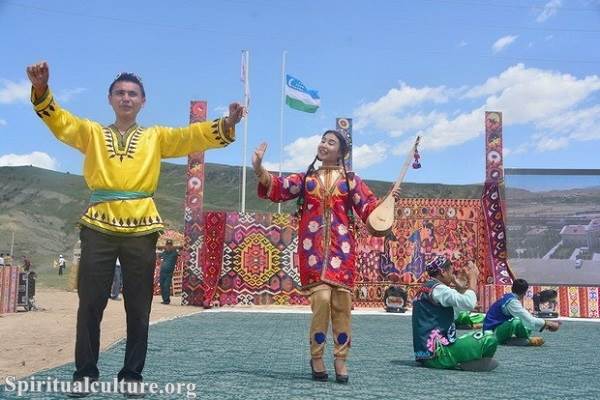Singapore, a vibrant city-state at the crossroads of maritime trade, has forged a unique identity not by fusion alone, but by a profound commitment to multicultural co-existence. Its culture is a stunning tapestry woven from the threads of Malay, Chinese, Indian, and Eurasian heritages. At Spiritual Culture, we recognise that the true influence of a tradition lies not merely in its visibility, but in the depth of its spiritual meaning, its historical continuity, and its power to bind communities.
The cultural landscape as of the Current Time of Writing, November 18, 2025, is characterized by dynamic preservation efforts. Major festivals continue to drive national rhythm, while daily practices like community dining are now globally recognized. Recent sociological studies underscore that for a vast majority of Singaporeans, their religious and spiritual ideas hold considerable influence over their worldview, emphasizing that these traditions are anything but relics—they are living, evolving pillars of society.
Our ranking transcends simple popularity. It is a deep, analytical perspective on the spiritual impact and enduring heritage of these practices, validated by their role in national identity, community cohesion, and their formal recognition on the world stage, such as the UNESCO Intangible Cultural Heritage lists. These are the traditions that truly nourish the nation’s stomach and spirit.
Table of the Top 10 Most Influential Cultural and Spiritual Traditions in Singapore
| Rank | Tradition | Primary Cultural Root | Spiritual Influence Score (1-10) | Current Status/Recognition (as of Nov 2025) |
|---|---|---|---|---|
| 1 | Hawker Culture (Community Dining) | Multicultural (Chinese, Malay, Indian) | 9.8 (Communal/National Identity) | UNESCO Intangible Cultural Heritage (2020) |
| 2 | Chinese New Year (Lunar New Year) | Chinese (Buddhist/Taoist/Folk) | 9.5 (Ancestor Veneration/Rites) | National Public Holiday; Highest Social Impact |
| 3 | Hari Raya Puasa (Eid al-Fitr) | Malay-Muslim (Islamic) | 9.3 (Spiritual Purification/Forgiveness) | National Public Holiday; End of Ramadan |
| 4 | Deepavali (Festival of Lights) | Indian (Hindu) | 9.1 (Triumph of Good Over Evil/Renewal) | National Public Holiday; Little India Cultural Hub |
| 5 | Vesak Day | Pan-Asian (Buddhist) | 8.9 (Enlightenment/Compassion/Charity) | National Public Holiday; Commemoration of Buddha |
| 6 | Thaipusam Procession | Indian (Hindu-Tamil) | 8.5 (Intense Devotional Sacrifice) | Major Annual Religious Procession |
| 7 | Kebaya Tradition | Peranakan/Malay/Javanese | 8.2 (Cross-Cultural Heritage/Identity) | UNESCO ICH Multinational Nomination (2024) |
| 8 | Qing Ming Festival (Tomb Sweeping) | Chinese (Confucian/Taoist) | 8.0 (Filial Piety/Ancestor Worship) | Observed Annually (April) |
| 9 | Hari Raya Haji (Eid al-Adha) | Malay-Muslim (Islamic) | 7.8 (Sacrifice/Faith/Social Responsibility) | National Public Holiday; Feast of Sacrifice |
| 10 | Traditional Lion and Dragon Dance | Chinese (Folk/Martial Arts) | 7.5 (Auspice/Warding Off Evil) | Highly Visible Cultural Performance |
10. Traditional Lion and Dragon Dance
The exhilarating spectacle of the Lion and Dragon Dance is an inherited performance art with roots deep in Chinese folk tradition and martial arts, integral to Singapore’s streetscape, especially during festive periods and business openings. While often viewed as sheer entertainment, its cultural context is fundamentally spiritual: these vibrant, synchronized movements are an active form of prayer and ritual cleansing. They serve to ward off negative spirits, chase away bad luck, and invoke blessings, prosperity, and auspicious fortune for the new year or a new venture, tying it inextricably to the economic and spiritual success of the community.

This tradition earns its place for its sheer symbolic power and its ability to transcend cultural boundaries. The drummers, cymbalists, and dancers become living conduits for powerful ancient symbols. The spiritual impact is palpable: the thunderous sound and rhythmic energy create an atmosphere of vibrant renewal, an energetic clearing that resonates throughout the urban environment. It is a loud, confident affirmation of a community’s desire for success and protection, acting as a powerful folk ritual for luck and fortune in a modern capitalist society.
The preservation of the Lion and Dragon Dance highlights the value of physical mastery in cultural expression. It demands immense discipline and teamwork, passing on not just choreography but an ethical tradition of respect and diligence. This tradition reminds us that the spiritual world is not always quiet and meditative; sometimes, it requires a confident, energetic display to secure the blessings needed for communal life and progress.
Cultural/Spiritual Highlights
- Folk ritual to ward off evil spirits and bring good fortune.
- The lion’s dance to ‘pluck the green’ (cai qing) is a symbolic act of claiming prosperity.
- Practitioners maintain a link to the Wushu (martial arts) spiritual discipline.
9. Hari Raya Haji (Eid al-Adha)
Hari Raya Haji, or the Feast of Sacrifice, is one of the two major Islamic holidays, centered around the ritual of Korban, the sacrifice of livestock. Celebrated by Singapore’s Malay-Muslim community and adherents of Islam, this tradition holds profound significance, marking the culmination of the annual Hajj (pilgrimage) to Mecca and commemorating Prophet Ibrahim’s (Abraham’s) profound obedience and faith in being willing to sacrifice his son. As of November 18, 2025, the practice continues to be a crucial demonstration of devotion and empathy across the community.
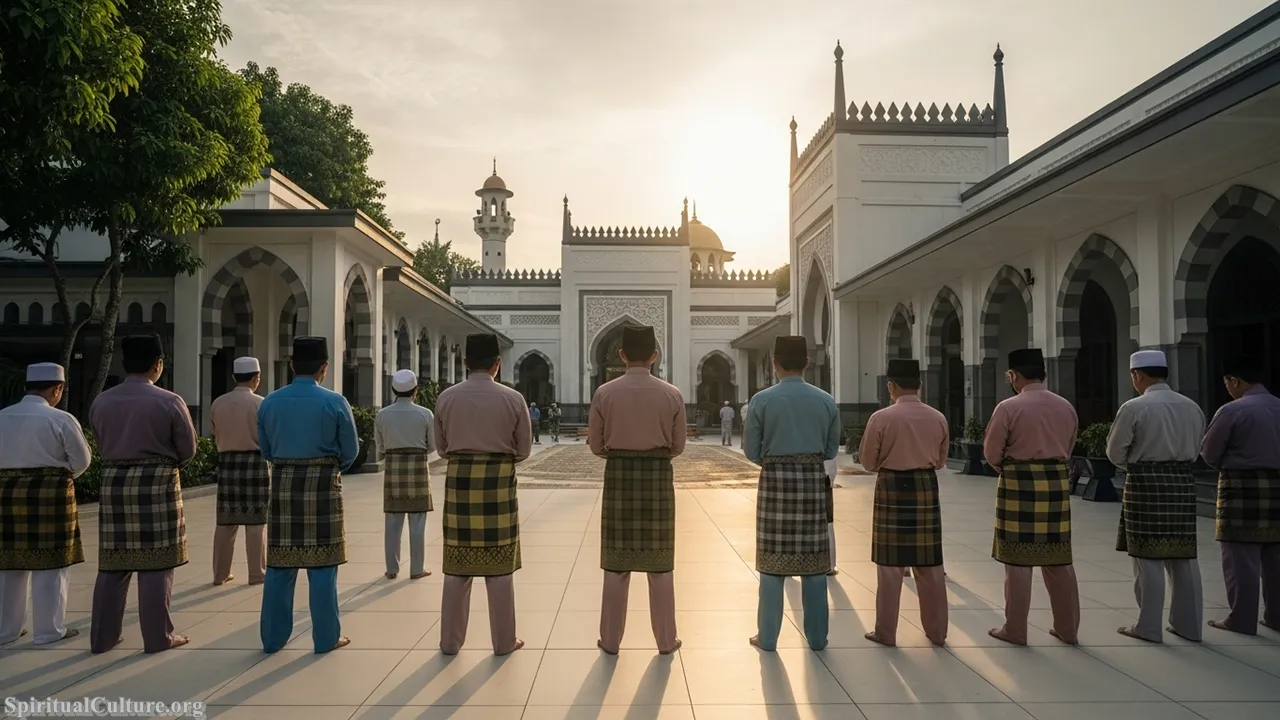
The reason for its ranking lies in the intensity of its core spiritual ritual: Korban. This act is a powerful, literal, and symbolic expression of submission to God’s will (Islam meaning submission) and a deep-seated commitment to charity. The meat from the sacrifice is meticulously divided and distributed to the poor, ensuring the blessing and spiritual lesson of sharing reaches the neediest. The spiritual impact is therefore a tangible demonstration of faith, where devotion is translated directly into social justice and community empathy.
The practice of Hari Raya Haji is a powerful moral lesson in humility and social responsibility. It urges every practitioner to look beyond personal gain and remember the spiritual value of selflessness and sharing one’s blessings, especially with the less fortunate. In a fast-paced urban environment, this tradition provides a crucial annual anchor, grounding the community in core religious teachings and reinforcing a collective sense of social and spiritual duty.
Cultural/Spiritual Highlights
- Commemorates Prophet Ibrahim’s unwavering faith and obedience.
- The Korban ritual symbolizes sacrifice and submission to divine will.
- Emphasizes charity and social equity through the mandated distribution of meat.
8. Qing Ming Festival (Tomb Sweeping Day)
The Qing Ming Festival is one of the most foundational spiritual traditions for the Chinese community, a dedicated day for ancestor veneration and tomb-sweeping. Observed annually, this practice sees families travel to cemeteries and columbariums to clean grave sites, make offerings of food, wine, and incense, and burn paper models of money and luxury goods for the comfort of their ancestors in the afterlife. Though not a public holiday, its observance is near-universal among followers of traditional Chinese religions (Confucianism, Taoism, and Chinese folk Buddhism), highlighting its enduring influence.
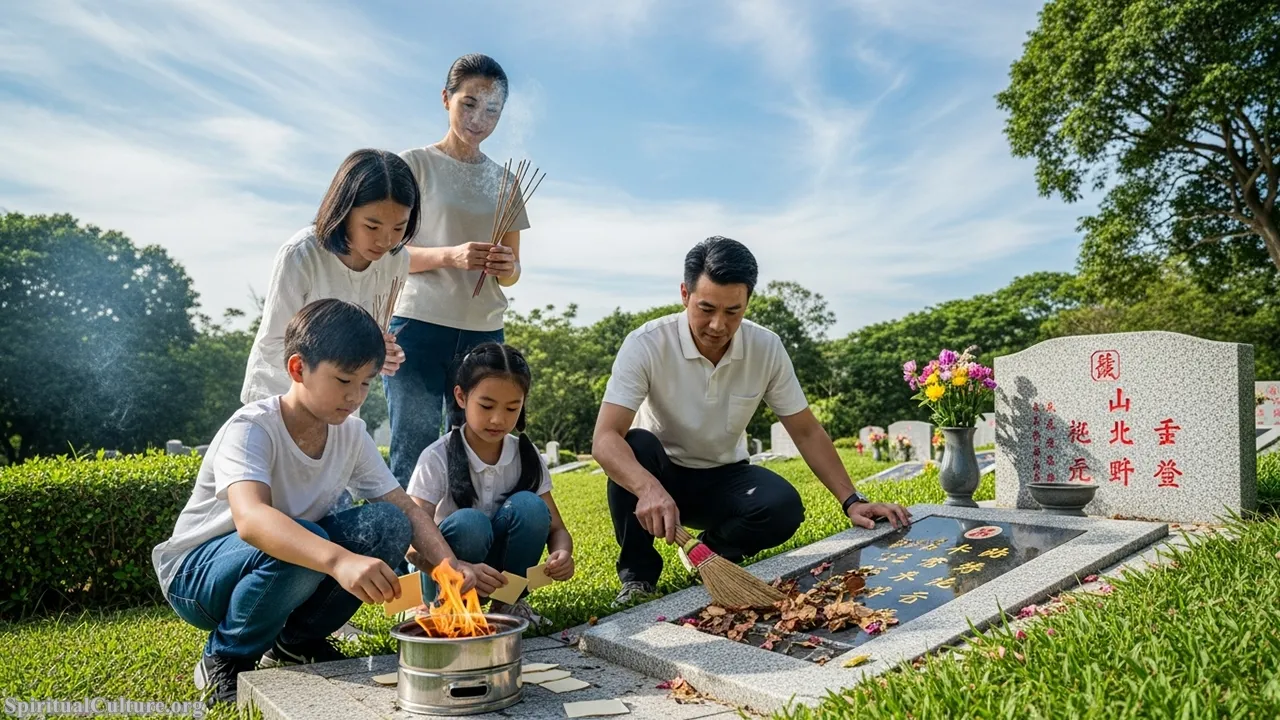
The central spiritual mechanism of Qing Ming is Filial Piety (Xiao), a cornerstone of Confucian ethics that has permeated Chinese folk religion. By honoring and caring for the deceased, the living reinforce the moral order, ensuring blessings, harmony, and continuity within the family lineage. The spiritual impact is the maintenance of a reciprocal relationship between the living and the dead: a ritual exchange where respect from the descendants ensures ancestral protection. It is a solemn, deeply personal, and spiritually significant rite of passage and duty.
The enduring value of the Qing Ming Festival in modern Singapore lies in its profound lesson on continuity and gratitude. It provides a necessary pause in the hyper-modern schedule for the remembrance of one’s roots and the recognition that current fortunes are built upon the efforts of previous generations. It is a powerful cultural tradition that sustains the core identity of the family unit, reminding all that, spiritually, we are never truly alone.
Cultural/Spiritual Highlights
- Core practice of Filial Piety (Xiao) in Chinese culture.
- Ritualistic provision for ancestors in the afterlife via paper offerings.
- Reinforces the belief in ancestral blessings for family harmony and prosperity.
7. Kebaya Tradition
The Kebaya, a beautifully embroidered long-sleeved blouse worn with a sarong, represents a transcendent cultural tradition that is more than just clothing—it is a living symbol of cross-cultural exchange and heritage. Primarily associated with the Peranakan (Straits Chinese) women and the Malay community, the Kebaya’s design elements reflect Indonesian, Chinese, and European influences. Its recent multinational inscription onto the UNESCO Representative List of the Intangible Cultural Heritage of Humanity in 2024 solidifies its status as an influential cultural emblem as of the Current Time of Writing.
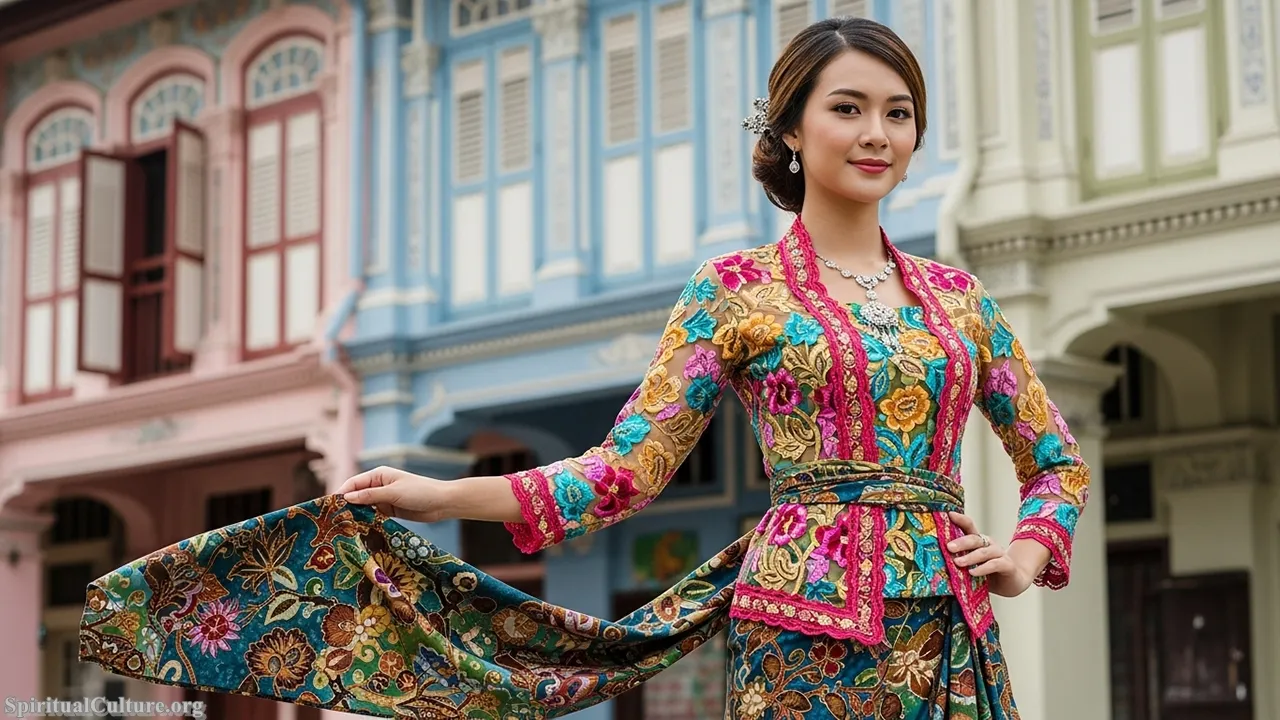
The Kebaya’s high ranking is due to its representation of Singapore’s multi-ethnic fabric. While its spiritual impact is subtle, it lies in its role as a marker of identity and dignity. Wearing the Kebaya is an act of acknowledging one’s specific heritage—be it Peranakan elegance or Malay modesty—and participating in a long-standing, generational tradition. It embodies the spiritual value of cultural resilience and the unique beauty that emerges from historical dialogue and adaptation across different faith and ethnic groups in Southeast Asia.
The preservation value of the Kebaya tradition is immense. It is a sartorial lesson in the strength of cultural blending, demonstrating how local traditions can adapt and survive colonial and global influences while retaining their essence. It encourages the younger generation to see their heritage not as static, but as a dynamic and beautiful expression of their unique position in the world, embodying grace and an unspoken reverence for the past.
Cultural/Spiritual Highlights
- Symbol of Peranakan and Malay heritage and identity.
- Multinational UNESCO ICH status (2024) highlighting regional cultural dialogue.
- Emblematic of cultural resilience and synthesis in a diverse society.
6. Thaipusam Procession
Thaipusam is arguably the most visually and spiritually intense Hindu festival celebrated in Singapore, a public spectacle of devotion to Lord Murugan, the Hindu God of War and Victory. Occurring during the Tamil month of Thai, the festival is marked by devotees embarking on a grueling, multi-mile procession carrying elaborate, often heavy, multi-spiked structures known as kavadis. This tradition is a powerful, living demonstration of faith, vows, and thanksgiving, remaining a major annual event as of November 18, 2025.
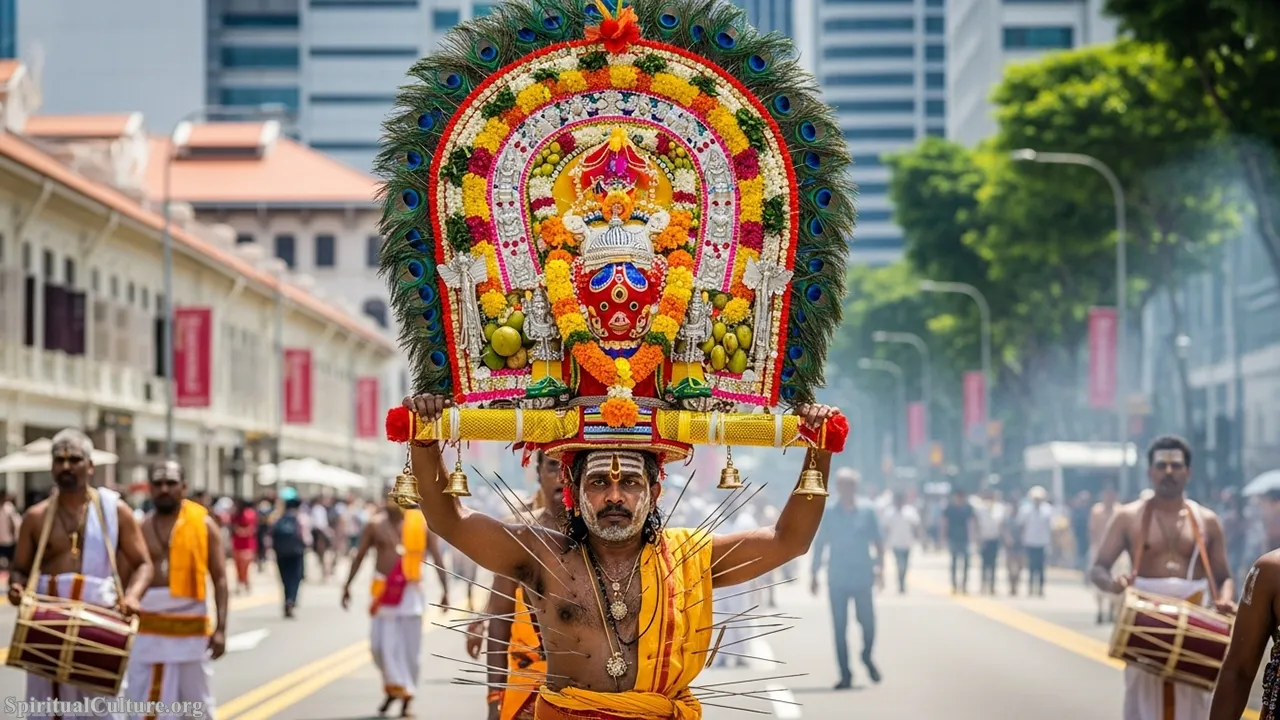
This tradition is ranked high for the sheer depth and visibility of its spiritual commitment. The physical ordeal of carrying the kavadi, which often involves piercing the body with skewers and hooks (under strict ritual conditions), is an act of intense penance and spiritual purification. Devotees often report entering a trance-like state, a spiritual transcendence where the pain is diminished by the power of devotion. The spiritual impact is a dramatic, public affirmation that faith can overcome physical limits, demonstrating a profound spiritual transaction of promise-making and fulfillment.
Thaipusam offers a powerful reflection on the concept of sacrifice for a greater spiritual goal. It teaches the enduring moral lesson that true gratitude sometimes demands a difficult, painful commitment—an act of self-discipline that strengthens the soul. The tradition stands as a cultural beacon, demonstrating the resilience of deeply rooted spiritual practices in the heart of a thoroughly modern city.
Cultural/Spiritual Highlights
- Primary ritual of carrying the kavadi as an act of penance and vow fulfillment.
- A powerful display of spiritual transcendence and devotion to Lord Murugan.
- The practice involves extensive ritual fasting and purification beforehand.
5. Vesak Day
Vesak Day is the most sacred day in the Buddhist calendar, commemorating the birth, enlightenment (Nirvana), and death (Parinirvana) of Siddhartha Gautama, the historical Buddha. As the largest single religious group in Singapore, the Buddhist community observes this day with immense spiritual focus. Activities include ceremonial bathing of the Buddha statue, extensive merit-making, chanting, and a strong emphasis on acts of charity and compassion (dana), affirming its central place in the nation’s spiritual life.

The profound spiritual impact of Vesak Day is derived from its tripartite commemoration, which serves as an annual ritual of spiritual renewal for millions. The ceremonial bathing of the Buddha statue is a spiritual exercise in self-purification, while the dedicated acts of dana—such as donating blood, freeing caged birds, and extensive charity—are direct expressions of the core Buddhist teachings of compassion and non-violence. It is a day dedicated not just to remembrance, but to actively generating good karma and purifying the mind.
The enduring preservation value of Vesak Day lies in its global message of peace, mindfulness, and empathy. The tradition provides a moral lesson that transcends sectarian differences, encouraging all to reflect on the cyclical nature of life, death, and rebirth, and the ultimate path to inner peace. It is a quiet, yet deeply powerful, spiritual counterpoint to the city’s material focus.
Cultural/Spiritual Highlights
- Commemorates the three cardinal events of the Buddha’s life.
- The ‘Bathing the Buddha’ ritual symbolizes self-purification.
- Emphasis on charity and good deeds (dana) to generate merit (karma).
4. Deepavali (Festival of Lights)
Deepavali, the Hindu Festival of Lights, is a major national celebration that signifies the profound spiritual and moral victory of light over darkness, good over evil, and knowledge over ignorance. Primarily observed by Singapore’s Hindu community, it sees a massive cultural output, with the streets of Little India transforming into a spectacular, months-long cultural hub of lights, bazaars, and traditional preparations. As a core cultural marker, it is a day of spiritual cleansing and joyful renewal.
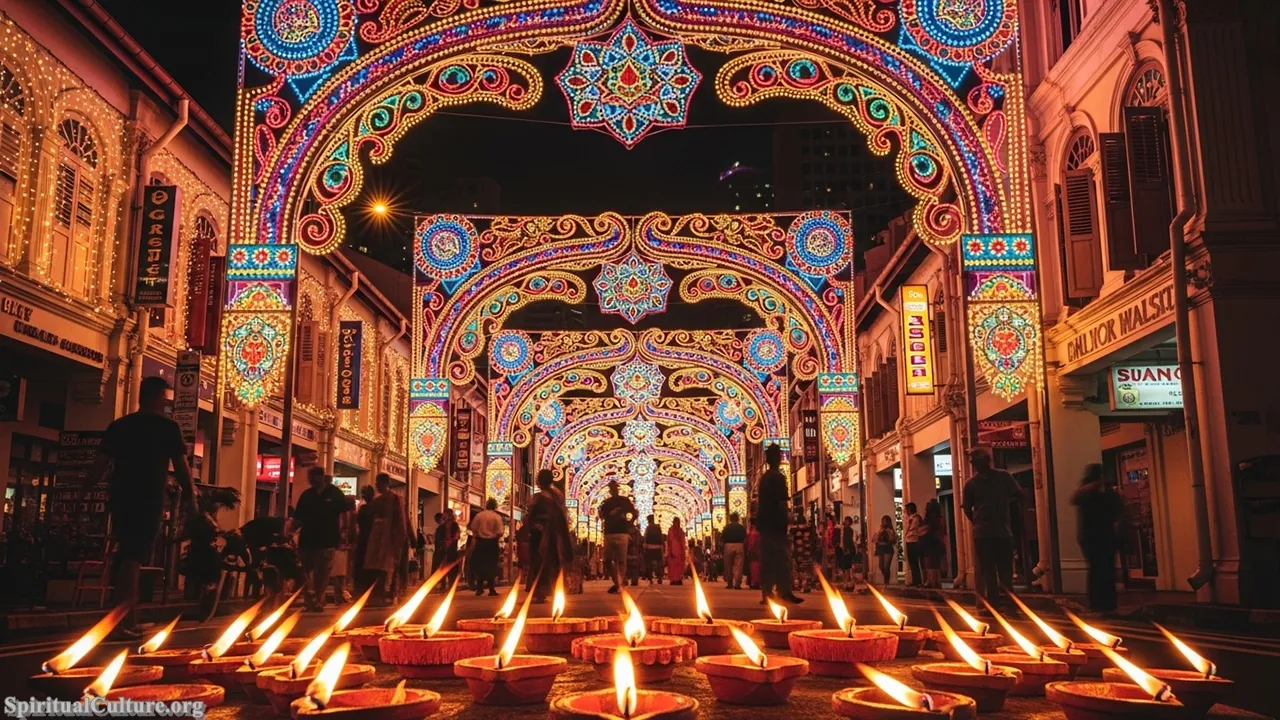
Deepavali is a powerhouse of spiritual influence, celebrating the return of Lord Rama to Ayodhya after defeating the demon king Ravana. Its spiritual impact is intensely personal and domestic: the lighting of small clay oil lamps (diyas) in every home is not just decoration, but a ritualistic welcoming of the goddess of wealth, Lakshmi, and a symbolic act of dispelling one’s inner darkness. It is an annual mandate for spiritual housekeeping, where the collective effort to illuminate the city reflects an inner commitment to renewal and the triumph of one’s higher nature.
The tradition’s moral lesson is one of hope and resilience—that even after the darkest period (symbolized by the preceding new moon night), light will ultimately prevail. In a multicultural setting, it stands as a brilliant reminder of shared human values and the universal quest for goodness. The Deepavali spirit encourages the community to embrace forgiveness, generosity, and a fresh start, ensuring the spiritual well-being of the family unit.
Cultural/Spiritual Highlights
- Symbolizes the victory of Light (Dharma) over Darkness (Adharma).
- The lighting of Diyas (oil lamps) is a ritualistic act of inner and outer illumination.
- A time for new beginnings, spiritual cleansing, and worshipping the Goddess Lakshmi.
3. Hari Raya Puasa (Eid al-Fitr)
Hari Raya Puasa, also known as Eid al-Fitr, marks the joyous conclusion of the holy month of Ramadan, a period of strict dawn-to-dusk fasting and intense spiritual introspection for the Malay-Muslim community. This tradition is a national event, characterized by morning communal prayers, seeking forgiveness from elders, and the practice of ‘open house’ where friends and family of all races visit. As one of the most visible and deeply integrated cultural and spiritual cycles, its influence is central to Singapore’s social harmony.
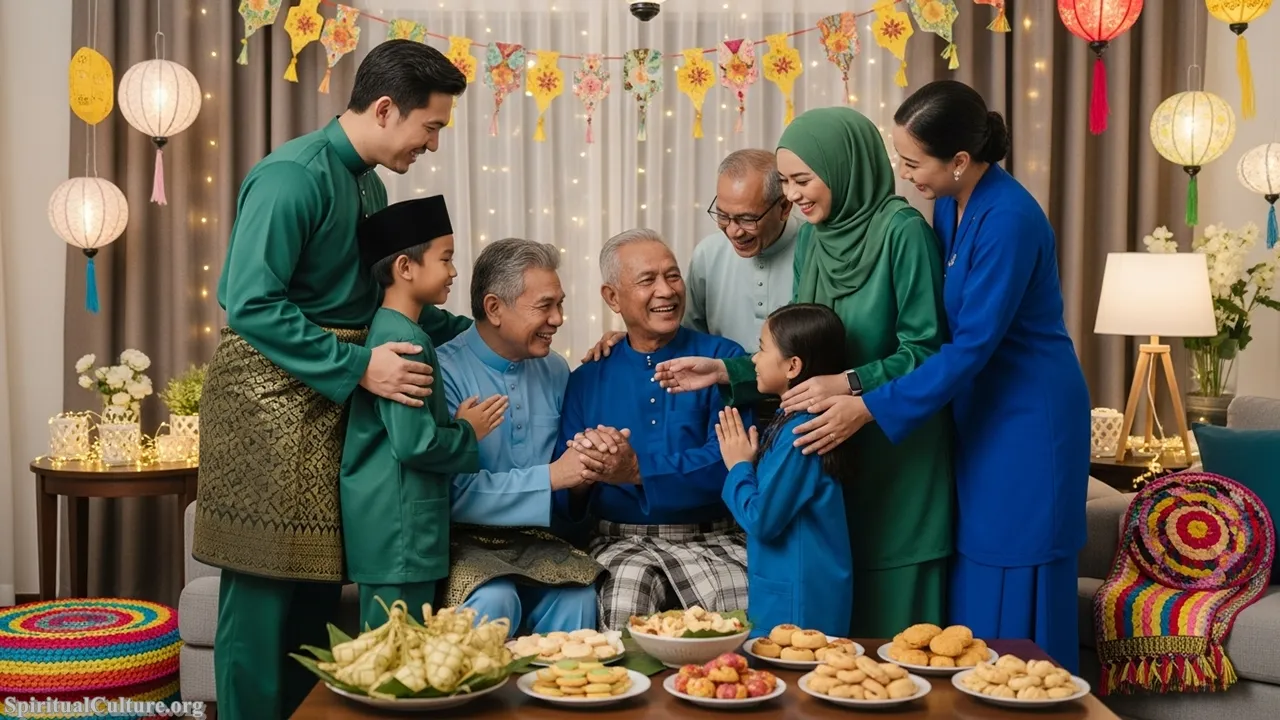
The deep spiritual influence of Hari Raya Puasa is intrinsically tied to the preceding month of Ramadan. The spiritual impact is a celebration of the success of soul purification through discipline and abstinence. The act of fasting fosters empathy, self-control, and heightened consciousness (taqwa). Hari Raya is the joyous culmination, a Festival of Forgiveness, where the ritualistic seeking of maaf zahir dan batin (forgiveness of body and soul) ensures the spiritual slate is wiped clean for the new year. This annual cycle of spiritual discipline and renewal is profound.
The tradition offers a powerful moral and preservation lesson in empathy and communion. The discipline of Ramadan teaches the importance of delayed gratification and awareness of the poor, while Hari Raya reinforces the value of reconciliation, family bonds, and the extension of generosity. It is a cultural expression that continuously revitalizes the spiritual core of a significant portion of the population.
Cultural/Spiritual Highlights
- Celebrates the successful spiritual purification of the soul after Ramadan.
- Central ritual of seeking forgiveness (maaf zahir dan batin) from family and friends.
- Reinforces communal prayers and the spiritual strength of the ummah.
2. Chinese New Year (Lunar New Year)
Chinese New Year (CNY) is the most widespread and highest-impact festival in Singapore, dominating the cultural, social, and commercial landscape for up to 15 days. While often celebrated with boisterous public events like the Chingay Parade, the core influence of CNY is rooted in deeply personal, spiritual traditions centered on family and prosperity. As the nation’s largest ethnic group observes this, the traditions of the reunion dinner, hongbao (red packet) exchange, and ancestor veneration shape the annual rhythm of the entire country, remaining supremely influential as of November 18, 2025.
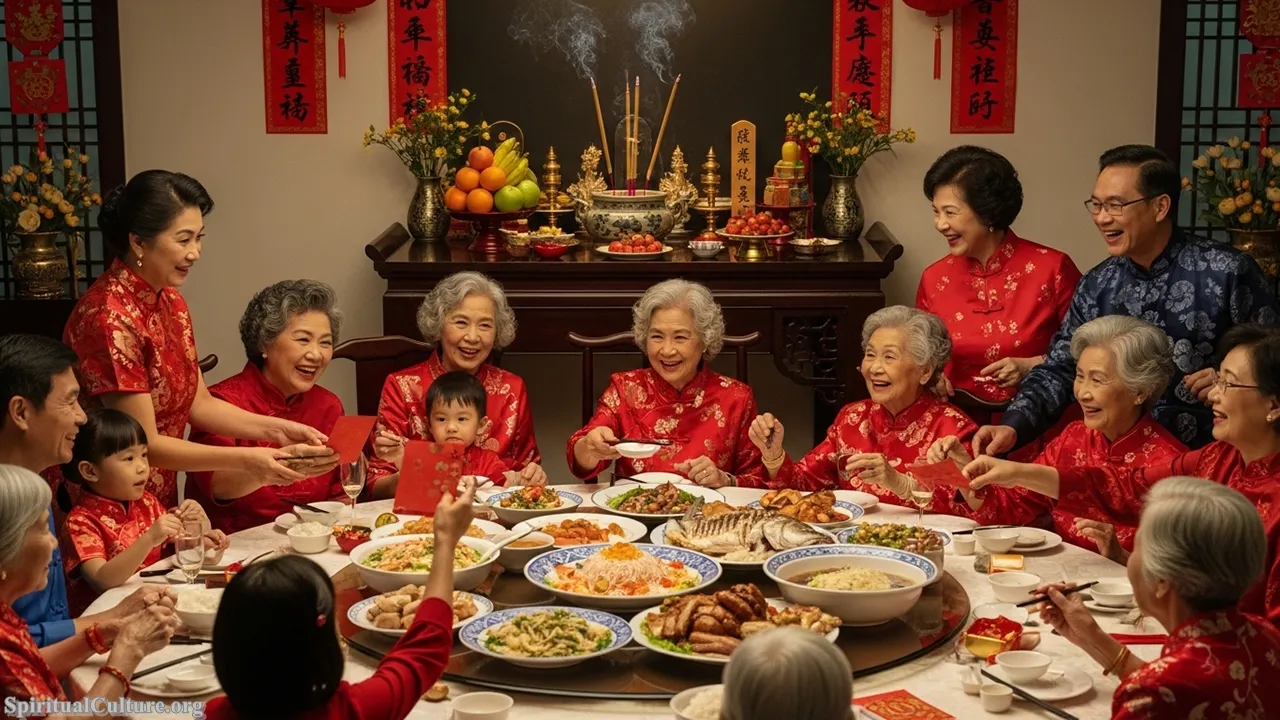
The spiritual impact of Chinese New Year is profound, revolving primarily around the restoration of family harmony and the invocation of good fortune. The reunion dinner is a sacred, symbolic act of communal belonging, honoring the entire lineage, including the ancestors. The rites often include explicit ancestor veneration (paying respects to family altars) and the symbolic cleansing of the home to sweep away bad luck. The exchange of hongbao is a physical transfer of well-wishes and blessings, a ritualistic act of ensuring prosperity and protection for the younger generation.
The moral lesson of this tradition is the primacy of Filial Piety and Lineage. It is an annual cultural reset that stresses connection, gratitude, and the generational transfer of spiritual authority and blessings. The enduring value lies in its success at maintaining strong family structures and a cultural emphasis on preparation and renewal, ensuring that the spiritual foundation of the family is robust for the coming year.
Cultural/Spiritual Highlights
- The Reunion Dinner is a sacred ritual uniting the living and the deceased.
- Deep-rooted practice of Ancestor Veneration (bai nian).
- The exchange of hongbao (red packets) as a ritualistic transfer of blessings and luck.
1. Hawker Culture (Community Dining)
At the apex of our list stands Hawker Culture in Singapore, an element recognized for its unique blend of culinary and cultural ingenuity, successfully inscribed onto the UNESCO Representative List of the Intangible Cultural Heritage of Humanity in 2020. This tradition is less a religious rite and more a secular spiritual practice of collective identity. It encompasses the community dining practices and the culinary skills found in over 100 hawker centers, defining the national palate and serving as the common ground for all races and classes.

Hawker Culture’s superlative influence lies in its function as the nation’s spiritual hearth. The spiritual impact is found in its spontaneous and profound role in fostering racial and religious harmony. In the hawker center, the spiritual values of tolerance, mutual respect, and community are practiced daily and unconsciously. It is the crucible where a Chinese diner, a Malay stall owner, and an Indian family can share a meal side-by-side, affirming a uniquely Singaporean identity that transcends ethnic lines. The act of sharing a table and enjoying shared national cuisine is a daily communion—a spiritual sustenance that validates the multiracial experiment.
The preservation lesson inherent in Hawker Culture is vital: true heritage is found in the everyday, not just the monumental. It teaches us the moral lesson that unity is not a government mandate, but a sustained, daily choice embodied in the act of sharing a meal. Its value, as of November 18, 2025, is not merely gastronomic, but deeply humanistic and central to the collective soul of the nation.
Cultural/Spiritual Highlights
- Officially inscribed as UNESCO Intangible Cultural Heritage (2020).
- Acts as a secular spiritual space fostering national identity and cohesion.
- Emphasizes the spiritual values of tolerance, community, and social equity.
Conclusion
As we conclude this deep dive into Singapore’s most influential cultural traditions, it is clear that the city-state’s strength is not just its economy, but the vibrant, enduring spirit of its people. From the profound, collective daily ritual of Hawker Culture to the intensely personal acts of devotion during Thaipusam and Hari Raya Puasa, these ten traditions form the bedrock of the Singaporean consciousness. They stand as magnificent, living proof that modernity and deep-rooted heritage are not mutually exclusive—they are, in fact, complementary forces.
At Spiritual Culture, we celebrate Singapore’s extraordinary commitment to cultural preservation and dialogue. These traditions are more than mere observations; they are the continuous, generational acts of faith, family, and community that define what it means to be Singaporean. They offer the world a powerful moral lesson: that a nation’s soul thrives when it makes space for every voice, every light, and every spiritual journey. We encourage all to not just witness these traditions, but to understand the DEEPER MEANING that makes Singapore truly unique as of the Current Time of Writing.
